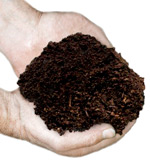Sustainable Gardening
MULCH
Not all compost has to be made in a bin or even by piling the makings up somewhere. Some of the best and most nutritious composts are those made right where they are going to be used, by the method known as sheet composting or sheet mulching. This is after all what nature mostly does since she is unable to gather waste into neat piles without human help.
~ Moira Ryan - Organic Gardener, Author & Professional Botanist - Zone 9, New Zealand
Mulch/Sheet Composting/Sheet Mulching
16 important benefits/reasons for use:
■ Enhances soil structure and overall health
■ Increases water infiltration into the soil
■ Improves nutrient and water retention
■ Saves water: Saves up to 73% of water loss through evaporation
■ Suppresses weed growth
■ Suppresses pathogens and pests
■ Prevents soil compaction
■ Provides a source of organic matter for the Soil Food Web
■ Increases healthy Soil Food Web: Soil microbial activity and worms
■ Improves plant vigor and health, which improves resistance to pests and diseases
■ Turns the soil into a living filter which removes pollutants from water, protecting our waterways
■ Helps moderate and maintain balanced soil
temperatures: Cooler in summer and helps
protect from freezes
■ Controls erosion
■ Reduces need for pesticides, herbicides,
and
fertilizers
■ Reduces waste: Composting and mulching green waste conserves dwindling landfill area. reducing greenhouses gases and air
pollution from transport
■ Reduces labor and maintenance costs: weeds are composted in place and the repeated use of chemicals are not needed
Mulch should never be applied to dry ground, as often this can cause it to become an impervious roof and shed water instead of allowing it to soak in, resulting in the mulch not providing its wonderful benefits.
It is not advisable to dig wood mulches into the soil. Mulch is best used as nature intended, applied to the surface where the soil organisms can draw on them as they are needed, and meanwhile they can act as good insulators, weed suppressers and moisture retainers, etc. As long as mulch is spread on the soil surface only, it is highly unlikely to rot quickly enough to cause nitrogen robbery of the topsoil. Left strictly alone, the fungi and bacteria will get the nitrogen out of the air to digest pure wood. Dig that stuff under and they will take it from the soil and there will not be any nitrogen available for the plants. Nitrogen deficient plants turn yellow and become weak and susceptible to pests and diseases.
(Nature's mechanism is geared to receiving raw materials at the surface and so the most efficient breakdown occurs in mulches and not in material dug into the ground, but the notion of digging stuff in has become so deeply entrenched that many people feel unhappy about tending a garden without any digging.)
